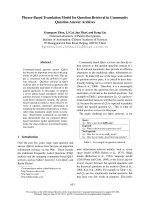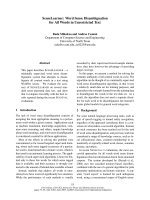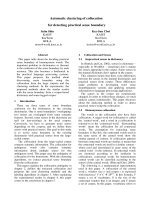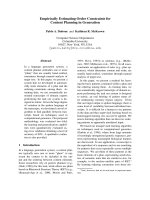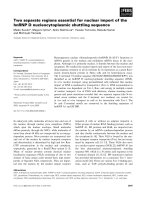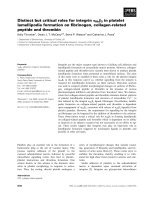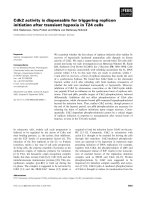báo cáo khoa học: " Glutathione synthesis is essential for pollen germination in vitro" ppt
Bạn đang xem bản rút gọn của tài liệu. Xem và tải ngay bản đầy đủ của tài liệu tại đây (5.89 MB, 11 trang )
RESEARC H ARTIC L E Open Access
Glutathione synthesis is essential for pollen
germination in vitro
Bernd Zechmann
1,2*
, Barbara E Koffler
1
and Scott D Russell
3
Abstract
Background: The antioxidant glutathione fulfills many important roles during plant development, growth and
defense in the sporophyte, however the role of this important molecule in the gametophyte generation is largely
unclear. Bioinformatic data indicate that critical control enzymes are negligibly transcribed in pollen and sperm
cells. Therefore, we decided to investigate the role of glutathione synthesis for pollen germination in vitro in
Arabidopsis thaliana accession Col-0 and in the glutathione deficient mutant pad2-1 and link it with glutathione
status on the subcellular level.
Results: The depletion of glutathione by buthionine sulfoximine (BSO), an inhibitor of glutathione synthesis,
reduced pollen germination rates to 2-5% compared to 71% germination in wildtype controls. The application of
reduced glutathione (GSH), together with BSO, restored pollen germination and glutathione contents to control
values, demonstrating that inhibition of glutathione synthesis is responsible for the decrease of pollen germination
in vitro. The addition of indole-3-acetic acid (IAA) to media containing BSO restored polle n germination to control
values, which demonstrated that glutathione depletion in pollen grains triggered disturbances in auxin metabolism
which led to inhibition of pollen germination.
Conclusions: This study demonstrates that glutathione synthesis is essential for pollen germination in vitro and
that glutathione depletion and auxin metabolism are linked in pollen germination and early elongation of the
pollen tube, as IAA addition rescues glutathione deficient pollen.
Keywords: Arabidopsis auxin, gametophyte, glutathione, indole-3-acetic acid, pollen
Background
Glutathione is an i mpor tant antioxidant and redox buffer in
eukaryotes and most prokaryotes that fulfills many roles in
plant metabolism a nd plant defense du ring abiotic and bio-
tic stress c onditions in the sporophyte [1], but its role
remains largely unknown for the gametophyte. I n the spor-
ophyte, glutathione is involved in the detoxification of r eac-
tive oxygen species (ROS), redox signaling, the modulation
of gene expression and in the regulation of enzymatic activ-
ities [extensively reviewed by 1]. Glutathione is also
involved in the detoxification of xenobiotics, herbicides
[2,3] heavy metals such as ca dmium [4-8], and protects pro-
teins from oxidation by a process called glutathionylation
[9-11]. The importan ce of glutathion e for pla nt growth an d
development is highlighted by the observation that impaired
glutathione synthesis correlates with growth defect s [12,13],
and that the complete absence of glutathione synthesis
results in a lethal phenotype [14]. Additionally, the redox
state of glutathione is also important for plant growth and
development. In non-stressed plants it occurs mainly in its
reduced form (GSH), whereas during oxidative stress high
amounts of oxidized glutat hione (GSSG) can be formed.
The occurrence of high amounts of GSSG correlates with
reduced growth, dormancy, or cell death [15-17].
Glutathione synthesis takes place in two ATP-
dependent st eps triggered by enzymes that are encoded
by single genes in Arabidopsis [18]. In the first
step cysteine is linked with glutamate to form
g-glutamyl cysteine. This reaction is triggered by g-gluta-
mylcysteine synthetase (GSH1). In the s econd step,
glycine is linked to g-glutamylcysteine by glutathione
synthetase (GSH2) to form the final product glutathione.
In Arabidopsis, these two steps seem to take place
exclusively in plastids and the cytosol, which are
* Correspondence:
1
University of Graz, Institute of Plant Sciences, Schubertstrasse 51, 8010 Graz,
Austria
Full list of author information is available at the end of the article
Zechmann et al. BMC Plant Biology 2011, 11:54
/>© 2011 Zechmann et al; licensee BioMed Central Ltd. This is an Open Access article distributed under the terms of the Creative
Commons Attribution License ( which permits unrestrict ed use, distribution, and
reproduction in any medium, provided the original work is properly cited.
therefore considered as the main centers of glutathione
synthesis [18]. In the sporophyte, transcripts of GSH1
and GSH2 and the final product, glutathione, can be
found in all major plant parts and in all cell organelles at
different concentrations (Additional files 1 and 2) [19,20].
According to immunohistochemistry and quantitative
transmission electron micro scopy, the highest levels of
glutathione have been detected in mitochondria and the
lowest in plastids. Vacuoles contained glutathione only
under certain conditions (e.g. high sulfur soil contents,
high amounts of oxidized glutathione) [21,22], whereas
glutathi one could not be detected i n cell walls [20].
Although the role and subcellular distribution of glu-
tathione in the sporophyt e are well defined, the necessity
and role of glutathione in the gametophyte remain largely
unexamined. Bioinformatic data cast doubt on the
importance of glutathione metabolism in the male game-
tophyte, as both GSH1 and GSH2 are transcribed at neg-
ligible levels in pollen a nd sperm cells (Additional files 1
and 2) [23,24]. Nevertheless, due to the apparent sensitiv-
ity of microspores to mitochondrial damage induced by
chronic oxidative stress [25], we decided to investigate
the necessity and localization of glutathione in the game-
tophyte in order to reveal strategies for pollen to cope
with ROS during tube germination and elongation.
In the current study, we investigate whether glu-
tathione is essential for pollen germination, and if so,
whether such pools of glutathione depend on new
synthesis or an existing glutathione pool available in the
pollen grains before the star t of germination. The s ub-
cellular distribution of glutathione will also reveal if
glutathione is distributed equally or shows compartment-
specific adaptations as found in leaf and root cells [20].
In order to achieve this goal we studied pollen germina-
tion rates and the subcellular distribution of glutathione in
pollen grains of wildtype plants treated with and without
buthionine sulfoximine (BSO). BSO is known to inhibit
the first enzyme of the glutathione synthesis pathway thus
leading to a str ong decrease in gl utathione levels [26-31].
Additionally, we studied pollen germination rates and the
subcellular distribution of glutathione in the pollen grains
of the pad2-1 mutant, which has a mutation of t he first
enzyme of the glutathione synthetic pathway thus redu-
cing the content of glutathione by 80% compared to the
wildtype [19,32]. Differences in glutathione contents
between the wildtype and the pad2-1 mutant should give
detailed insight into the roles of temporary and permanent
glutathione depletion on pollen germination in vitro.
Results
Pollen germination
Wildtype pollen grains showed a germination rate of
71% when grown on germination medium without GSH
and BSO (Figure 1 and Figure 2). Treatment of 0.1 mM
BSO, which depletes glutathione, decreased pollen ger-
mination rate to about 5%. To examine whether glu-
tathione depletion may be linked with decreased levels
of auxin, which is one of the most important plant
Figure 1 Images showing the effect of BSO and GSH treatment on pollen germination in Col-0. Light microsco pical images show
Arabidopsis thaliana accession Col-0 pollen grains after 16 h incubation on solidified pollen germination media containing (a) no GSH and BSO
(control), (b) 0.1 mM BSO, (c) 0.1 mM BSO and 1 mM GSH, and (d) 0.1 mM BSO and 3 mM GSH. Original images were inverted and germinating
pollen grains were marked with white circles for better visualization. Bars = 100 μm.
Zechmann et al. BMC Plant Biology 2011, 11:54
/>Page 2 of 11
hormones for pollen tube growth [33,34], we have
applied 22.8 μM indole-3-acetic acid (IAA) together
with BSO in the growth media. The addition of IAA to
growth media cont aining BSO restored pollen germina-
tion rate to levels similar to the control (69%; Figure 2
and Figure 3). Similar levels w ere reached (73%) when
pollen germination was performed on pollen germina-
tion media containing only IAA (Figure 2 and Figure 3).
The addition of 1 mM GSH to the media containing 0.1
mM BSO restored pollen germination rate to 60%.
A similar rate (64%) was found when wildtype pollen
grains (without BSO) were allowed to germinate on
media containing 1 mM GSH. Pollen germination rate
was reduced to 12% when higher concentrations of GSH
(3 mM and 5 mM) were added to the growth medium
(Figure 2). A similar germination rate (16% and 11%,
respectively) was observed after pollen grains were
transferred onto pollen germination media containing
0.1 mM BSO and either 3 mM or 5 mM GSH (Figure 1
and Figure 2). The addition of IAA to the pollen media
containing 3 mM and 5 mM GSH did not significantly
change pollen germination (Figure 2). Higher BSO con-
centrations (1.5 mM and 5 mM) had similar inhibitory
effects on pollen germination rate as observed using
media containing 0.1 mM BSO (Additional file 3).
Nevertheless, the addition of 1 mM GSH only partially
restored pollen germination rate (29% and 12%) when
added to 1.5 mM and 5 mM BSO, respectively. The
addition of 3 mM GSH to pollen germination media
containing 1.5 mM and 5 mM led to pollen germination
at rates of 14% and 5%, respectively (Additional file 3).
Pollen germination of the pad2-1 mutant was around
16% on medium without GSH and BSO (Figure 4 and
Figure 5). Similar levels were reached (16%) when pollen
germinationwasperformedonpollengermination
Figure 2 Statistical analysis of the effects of BSO, GSH, and IAA
treatment on pollen germination rate in Col-0. Graph shows
Arabidopsis thaliana accession Col-0 pollen germination rates (%)
after 16 h incubation on solidified pollen germination media
containing different concentrations of BSO (0.1 mM), GSH (1, 3, or 5
mM) and IAA (22.8 μM) for 16 hours. Data represent means and
standard errors. Different lowercase letters indicate significant
differences (P < 0.05) analyzed with the Kruskal-Wallis test followed
by post-hoc comparison according to Conover. N > 2000 pollen
grains per treatment from 3 or more independent experiments.
Figure 3 Images showing the effect of IAA treatment on pollen germination. Light microscopical images show pollen grains of Arabidopsis
thaliana accession Col-0 (a, b) and the pad2-1 mutant (c, d) after 16 h incubation on solidified pollen germination media containing a, c) 22.8
μM IAA and b, d) 0.1 mM BSO and 22.8 μM IAA. Pollen grains were marked with white circles for better visualization. Bars = 100 μm.
Zechmann et al. BMC Plant Biology 2011, 11:54
/>Page 3 of 11
media containing IAA (Figure 3 and Figure 5). Treat-
ment of 0.1 mM BSO decreased pollen germination rate
to 6%. The addition of auxin to growth media contain-
ing BSO restored pollen germin ation rates to levels
similar to the control (14%; Figure 3 and Figure 5). Add-
ing 1 mM and 3 mM GSH to the medium containing
0.1 mM BSO increased pollen germination rate to 16%
and 25%, respectively (Figure 4 and Figure 5). Similar
levels were found when 1 mM GSH and 3 mM GSH
were added to pollen germination m edia without BSO
(21% and 26%, respec tively). The addition of 5 mM
GSH to medium containing 0.1 mM BSO decreased pol-
len germination rates to 5%, which was similar to the
germination rate of pollen grown on medium with the
addition of 5 mM GSH (Figure 5). The addition of IAA
to the growth medium containing 3 mM and 5 mM
GSH did not affect pollen germination and was similar
to the germination rate of pollen grown on 3 mM and 5
mM GSH alone (Figure 5). The addition of higher BSO
concentrations (1.5 mM and 5 mM) decreased pollen
germination rates to 6% and 4%, respectively (Additional
file 4). The addition of 1 mM and 3 mM GSH to media
containing 1.5 mM BSO restored pollen germination
rates t o 23% and 10%, respectively. Adding 1 mM GSH
Figure 4 Images showing the effects of BSO and GSH treatment on pollen germination in pad2-1. Light microscopical images show
pollen grains of the Arabidopsis thaliana mutant pad2-1 after 16 h incubation on solidified pollen germination media containing (a) no GSH and
BSO (control), (b) 0.1 mM BSO, (c) 0.1 mM BSO and 1 mM GSH, and (d) 0.1 mM BSO and 3 mM GSH. Original images were inverted and
germinating pollen grains were marked with white circles for better visualization. Bars = 100 μm.
Figure 5 Statistical analysis of the effects of BSO, GSH, and IAA
treatment on pollen germination rate in pad2-1. Graph shows
pollen germination rates (%) of pollen obtained from the
Arabidopsis thaliana mutant pad2-1 after 16 h incubation on
solidified pollen germination media containing different
concentrations of BSO (0.1 mM), GSH (1, 3, or 5 mM) and IAA (22.8
μM) for 16 hours. Data represents means and standard errors.
Different lowercase letters indicate significant differences (P < 0.05)
analyzed with the Kruskal-Wallis test followed by post-hoc
comparison according to Conover. N > 2000 pollen grains per
treatment from 3 or more independent experiments.
Zechmann et al. BMC Plant Biology 2011, 11:54
/>Page 4 of 11
and 3 mM GSH to media containing 5 mM BSO
increased the pollen germination rates of the pad2-1
mutant to 11% and 6%, respectively (Additional file 4).
Glutathione labeling
Immunogold particles localized to glutathione were
found in all cell compartments except cell walls and
vacuoles (Figure 6). Gold particle density was much
higher in polle n obtained f rom wildtype plants than in
pad2-1 mutants (10.8 and 2.2 g old particles per μm
2
,
respectively; Figure 7 and Figure 8). Mitochondria, plas-
tids, nuclei a nd the cytosol contai ned equally dense
quantities of gold particles bound to glutathione (Figure
6 and Figure 9). Gold particle density was similar in
wildtype pollen grains which were allowed to germina te
on medium without GSH and BSO (10.8 gold particles
per μm
2
) and on media containing 1 mM GSH with and
without 0.1 mM BSO (11.3 and 9.9 gold particles per
μm
2
, respectively). An increase in glutathione contents
in wildtype pollen between 161% and 153% was
observed when 3 mM GSH was added to the media
with or without 0.1 mM BSO, respectively (Figure 7).
The treatment of pollen grains from Col-0 and the
pad2-1 mutant with BSO decreased gold particle density
to background levels (<0.1 gold particles per μm
2
;Fig-
ures 6, 7, 8, 9).
Pollen grains from the pad2-1 mutant contained lower
glutathione-labeling density (2.2 gold particles per μm
2
)
than wildtype (Figure 8), whereas the addition of 1 mM
GSH and 3 mM GSH to the germination media
increased glutathione contents to values similar to pol-
len grains from wildtype plants (8.7 and 29 gold
Figure 6 Transmission electron microgr aphs showing the subcellular distribution of glutathione in Col-0 pollen grains.Goldparticles
bound to glutathione could be found evenly distributed in plastids (P), mitochondria (M), and the cytosol but not in lipid bodies (L), vacuoles
(V) and cell walls of pollen grains obtained from Arabidopsis thaliana accession Col-0. Pollen grains were grown on solidified pollen germination
medium for 5 hours with either (a) no GSH and BSO (control), (b) 0.1 mM BSO, (c) 1 mM GSH, (d) 0.1 mM BSO and 1 mM GSH, (e) 3 mM GSH,
and (f) 3 mM GSH and 0.1 mM BSO prior to fixation. Bars = 1 μm.
Zechmann et al. BMC Plant Biology 2011, 11:54
/>Page 5 of 11
particles per μm
2
, respectively). Similar gold particle
densities were reached when 0.1 mM BSO was added to
GSH (Figure 8).
Discussion
The results o f this st udy clearly demonstrate that glu-
tathione synthesis is essential for pollen germination in
vitro. Despite negligible levels of GSH1 and GSH2 tran-
scripts occurring in pol len and sperm cells [23,24], glu-
tathione was found to be clearly present and active in
the male gametophyte. Pollen germination rates of wild-
type pollen, used as controls in the current study (71%),
were similar to those observed in previous studies under
similar conditions [35]. Inhibition of glutathione synth-
esis by BSO decreased the pollen germination rate to
about 5%, which could be correlated with the absence of
glutathione specific labeling in our immunogold assays.
BSO inhibits the first enzyme (GSH1) of the glutathione
synthesis pathway, which leads to a decrease or com-
plete absence of glutathione in leaves [26-31]. In pollen
grains of the pad2-1 mutant, in which glutathione
synthesisisdistortedbyasinglepointmutationin
GSH1, decreasing glutathione content to ~20% of wild-
type [32] a similar result is observed. Pollen germination
of the pad2-1 muta nt was reduced to about 16%, and
correlated with an 80% reduction in glutathione specific
immunolabeling when compared to the wildtype. A
further decrease of pollen germination rate to 5% was
accomplished by the addition of BSO to the growth
media. Similar results have al so been observed during
germ tube development in Candida albican s. Similarly,
strong depletions in GSH contents induced by 1-chloro-
2,4 dinitrobenzene were correlated with very significant
reductions in germ tube formation capacity and severe
cell mortality [36]. The addition of 1 mM GSH to
growth media containing BSO, could restore pollen ger-
mination rate and glutathione specific labeling to values
similar to the controls in pollen from both wildtype
plants and the pad2-1 mutant. Thus, these results
clearly demonstrate that glutathione synthesis and the
availability are essential for pollen germination and
demonstrate the importance of glutathione not only for
plant development but also for pollen germination and
tube growth. Additionally, these results showed that pol-
len grains where glutathione synthesis was inhibited by
BSO were able to import glutathione from the growth
medium by unknown mechanisms. This could be
important considering that glutathione uptake transpor-
ters have not been identified yet at the plasma mem-
brane and that negligible transcripts levels of GSH1 and
GSH2 were found in pollen and sperm cells [23,24].
The pad2-1 GSH1 point mutant showed a much
lower pollen germination rate (71% vs. 16%, respec-
tively), which presumably correlates with a much lower
Figure 8 Statistical analysis of gold par ticl e density in pollen
grains of pad2-1. Total amount of gold particles bound to
glutathione per μm
2
in pollen grains of the Arabidopsis thaliana
mutant pad2-1. Pollen grains were incubated for 5 hours on
solidified pollen germination media containing different
concentrations of BSO (0.1 mM) and GSH (1 or 3 mM). Data
represent means and standard errors. Different lowercase letters
indicate significant differences (P < 0.05) analyzed with the Kruskal-
Wallis test followed by post-hoc comparison according to Conover.
N > 20 pollen grains per treatment from 2 independent
experiments.
Figure 7 Statistical analysis of the subcellular distribution of
glutathione in pollen grains of Col-0. Total amount of gold
particles bound to glutathione per μm
2
in pollen grains of
Arabidopsis thaliana accession Col-0. Pollen grains were incubated
for 5 hours on solidified pollen germination media containing
different concentrations of BSO (0.1 mM) and GSH (1 or 3 mM).
Data represent means and standard errors. Different lowercase
letters indicate significant differences (P < 0.05) analyzed with the
Kruskal-Wallis test followed by post-hoc comparison according to
Conover. N > 20 pollen grains per treatment from 2 independent
experiments.
Zechmann et al. BMC Plant Biology 2011, 11:54
/>Page 6 of 11
glutathione content (-80%) when compared to the wild-
type. As the pad2-1 mutant a ccumulates only about
20% glutathione levels of the wildtype [32], these results
demonstrate that glutathione contents in pollen grains
strongly depend on adequate glutathione availability in
the plant. Compartment-specific differences (e.g., accu-
mulation of glutathione in mitochondria), as observed in
leaves and roots of the pad2-1 mutants [19], could not
be detected in pollen grains where glutathione concen-
trations were found to be distributed in all typically
labelled cell compartments equally. A slightly higher
germination rate of pad2-1 pollen (about 25%) could be
accomplished by the addition of 3 mM GSH to the
growth media, which still displayed far below the normal
germination rate of wildtype control pollen grains (71%)
and was similar to the germination rate achieved when
pollen grains from the wildtype were treated with the
same GSH concentration (16%). The addition of 5 mM
GSH dec reased poll en germinati on rate in both wildtype
and pad2-1 mutants to 12% and 6%, respectively, demon-
strating that high levels of GSH negatively affect the ability
of pollen grains to germin ate. It has been demonstrated
recently that the treatment of roots with high levels of
GSH can cause severe ultrastructural alterations [31,37].
Additionally, it has been demonstrated that in GSH-over-
expressing tobacco plants, elevated glutathione biosyn-
thetic capacity in the chloroplasts paradoxically increased
oxidative stress, leading to severe ultrastructural altera-
tions wi thin chloroplasts and to their ultimate degenera-
tion, eventuating in the death of the cell [38]. Even though
such ultrastructural changes have not been observed dur-
ing the present study, treatment of pollen grains with high
Figure 9 Transmission electron micrographs showing the subcellular distribution of glutath ione in pollen grains of pad2-1.Gold
particles bound to glutathione could be found evenly distributed in plastids (P), mitochondria (M), and the cytosol but not in lipid bodies (L),
vacuoles (V) and cell walls in pollen obtained from the Arabidopsis thaliana mutant pad2-1. Pollen grains were grown on solidified pollen
germination medium for 5 hours with either (a) no GSH and BSO (control), (b) 0.1 mM BSO, (c) 1 mM GSH, (d) 0.1 mM BSO and 1 mM GSH, (e) 3
mM GSH, and (f) 3 mM GSH and 0.1 mM BSO prior to fixation. Bars = 1 μm.
Zechmann et al. BMC Plant Biology 2011, 11:54
/>Page 7 of 11
levels of GSH (e.g. 3 and 5 mM GSH) could potentially
inhibit pollen germinat ion (e.g., by changing the internal
redox status). The appl ication of BSO together with IAA,
one of the most important hormones regulating pollen
tube growth [33,34] restored the rate of pollen germina-
tion in the pad2-1 mutant to about 14%, which was similar
to levels achieved by untreated pollen of t he pad2-1
mutant used as control. The same experiment restored the
rate of pollen germination in the wildtype of BSO-treated
pollen to over 60%. Thus, these results demonstrate that
low glutathione levels in pollen grains of the pad2-1
mutant must have altered their ability to germinate in the
long term. It has been demonstrated recently that the
accumulation of ROS in mitochondria was found to be
critical for proper pollen development, as sterile pollen
grains showed decreased pools of ATP and NADH and
lower activity of mitochondria DNA [25]. As glutathione is
essential for the detoxification of ROS/H
2
O
2
in plants it
seems likely that the low germination rates of pollen grains
from the pad2-1 mutants were caused by low glutathione
levels in the plant and pollen grains during pollen develop-
ment in the stamen. Nevertheless, pollen grains are
thought to possess resistance against or ability to downre-
gulate production of stigma-associated ROS/H
2
O
2
(e.g. by
antioxidants) in order to germinate on and penetrate
through the stigma [39]. As pollen germination of pad2-1
pollen grains coul d be only partly increased by the addi-
tion of 1 and 3 mM GSH (from 14% to 16% and 25%,
respectively) but never reached rates of the wildtype (71%)
these results also suggest that insufficient glutathione is
present without activity of GSH1 to permit normal rates
of germination. Thus, we can conclude that sufficient glu-
tathione contents are required during pollen development
and also during pollen germination for proper pollen ger-
mination of pollen from the pad2-1 mutant.
Since a reduction of root growth induced by the
depletion of GSH is caused by the i nhibition of auxin
transport [40,41], we tested if inhibited pollen germina-
tion by BSO can be restored by treatment with IAA,
which is one of the most important plant hormones for
pollen tube growth [33,34]. Results of this study demon-
strated that the application of BSO together with IAA
diminished the deleterious effects of BSO and led to
pollen germination rates similar to that of control pol-
len. The addition of IAA alone or together with GSH
did not have such affects. Thus, we can conclude that
glutathione depletion in pollen grains triggered distur-
bances in auxin metabolism which are linked with inhi-
bition of pollen germination induced by BSO treatment.
Conclusions
Summing up, it can be concluded that glutathione
synthesis is essential for p ollen germination in vitro.
Additionally, it was demonstrated that low glutathione
levels in the pad2-1 mutant decreased their ability to
germinate caused by disturbances most probably during
pollen development. The mechanisms behind the reduc-
tion of pollen germination induced by glutathione deple-
tion could be correlated with disturbances in auxin
metabolism which still have to be explored in more
detail.
Methods
Plant material
After stratificat ion for 4 days at 4°C, seeds of Arabidopsis
thaliana [L.] Heynh. Ecotype Columbia (Col-0) originally
obtained from the European Arabidopsis stock centre
(NASC; Loughborough, UK), and the glutathione defi-
cient mutant line pad 2-1 weregrownonsoilingreen-
house conditions with approximately 16/8 h day/night
photoperiod. Day and night temperatures were 22°C and
18°C, respectively. The relative humidity was 60% and
the plants were kept at 100% relative soil water content.
Light intensity varied between 120-150 μmol m
-2
s
-1
.
Determination of pollen germination
Four to six weeks after flowe ring, pollen was harve sted
from about 20 different plants for each experiment and
transferred onto pollen germination medium mounted
on glass slides, which were kept and prepared in moist
chambers at 22°C. Pollen germination medium was
always prepared fresh with double distilled water and
contained 5 mM CaCl
2
,1mMMgSO
4
, 5 mM KCl, 0.01
mM H
3
BO
3
, 10% sucrose and 1.5% agarose. The pH-
value was adjusted to 7.5 with a 1 M NaOH solution. In
addition, different concentrations of reduced glu tathione
(GSH), buthionine sulfoximine (BSO), and indole-3-
acetic acid (IAA) were added to the germination medi a.
Pollen germination media contained either (a) no GSH
and BSO (control), (b) 22.8 μMIAA,(c)0.1mMBSO,
(d) 0.1 mM BSO and 22.8 μM IAA, (e) 1 mM GSH, (f)
1 mM GSH and 0.1 mM BSO, (g) 3 mM GSH, (h) 3
mMGSHand0.1mMBSO,(i)3mMGSHand22.8
μMIAA,(j)5mMGSH,(k)5mMGSHand0.1mM
BSO, and (l) 5 mM GSH and 22.8 μM IAA. In prelimin-
ary studies additional concentrations of BSO and GSH
were tested (1.5 mM BSO and 5 mM BSO with or with-
out the addition of 1 mM and 3 mM GSH) in order to
evaluate the ideal BSO and GSH concentrations for the
proposed experiments. IAA concentration was chosen
according to previous studies which demonstrated that
the addition of 22.8 μM(4mgL
-1
) IAA stimulated pol-
len tube growth most effectively [33,34]. Therefore, 100
mM stock solutions of GSH, BSO and IAA respectively,
were prepared and small aliquots of these solutions
were added to the pollen germination media to reach
the final concentration of GSH, BSO, and IAA. The pH-
value of the media was adjusted to 7.5 with a 1 mM
Zechmann et al. BMC Plant Biology 2011, 11:54
/>Page 8 of 11
NaOH-solution. After transferring pollen on the germi-
nation media, grains were allowed to germinate in the
dark at 22°C in a temperature cont rolled incubator.
Slides were either examined for pollen germination rates
under a Zeiss Stemi SV11 or an Ol ympus Provis AX 70
microscope (Olympus, Life and Material Science Europa
GmbH, Hamburg, Germany) 16 hours later. Digital
images were taken of several randomly chosen areas on
the slides containing pollen grains and the amount of
poll en that germinated was determined with the help of
the image analysis software Olympus Cell D (Olympus,
Life and Materia l Science Europa GmbH, Hamburg,
Germany).
Sample preparation for electron microscopy
Pollen grains were allowed to germinate on solidified pol-
len germination media containing different concentrations
of GSH and BSO for 5 hours. Then they were covered
with 2.5% low melting agarose and transferred in the fixa-
tive solution after the agarose was solidified (within 30 sec-
onds). For electron microscopical analysis pollen grains
were fixed in 2.5% paraformaldehyde and 0.5% glutaralde-
hyde in 0.06 mM phosphate buffer (pH 7.5) containing
10% sucrose for 45 minutes. Samples were washed in buf-
fer 4 times 15 minutes and dehydrated in increasing con-
centrations of acetone (50%, 70%, and 90%) for 2 times 10
minutes for each step. Infiltration was carried out with
increasing concentrations of LR-White re sin (30%, 50%,
and 70%) mixed with 90% acetone with a minimum of 3
hours per step. Samples were then infiltrated with 100%
LR-White resin for 4 hours and embedded in fresh resin
for 48 hours at 50°C. Ultrathin sections (80 nm) were cut
with a Reichert Ultracut S ultramicrotome (Leica, Micro-
systems, Vienna, Austria).
Cytohistochemical investigations
Immunogold labeling of glutathi one was conducted
using ultrathin sections mounted on coate d nickel grids
and labeled with the Leica EM IGL automated immuno-
gold labeling system (Leica, Microsystems, Vienna, Aus-
tria) according to Zechmann et al. and Zechmann and
Müller [19,20]. For cytohistochemical analysis, samples
were blocked with 2% bovine serum albumin (BSA) in
phosphate buffered s aline (PBS, pH 7.2) for 20 min at
room temperature. The sections were then treated with
the primary antibody against glutathione (anti-glu-
tathione rabbit polyclonal immunoglobulinG [IgG];
Millipore Corp., Billerica, MA, U.S.A.) diluted 1:50 in
PBS for 2 h. After short rinses in PBS (3 times 5 min)
the samples were incubated with a 10 nm gold-conju-
gated secondary antibody (goat anti rabbit IgG; British
BioCell International, CardiV, UK) diluted 1:50 in PBS
for 90 min. After short washes in PBS (3 time s 5 min)
and distilled water (2 times 5 min) labeled grids were
either immediately observed in a Philips CM10 trans-
mission electron micros cope or post stained with ura-
nyl-acetate (2% dissolved in double distilled water) for
15 s. Post staining with uranyl acetate was applied to
facilitate the distinction of different ce ll structures
enabling a clearer identification of the investigated
organelles.
Quantitative analysis of immunogold labeling
Micrographs of randomly photographed immunogold
labeled sections of pollen grains were digitized and go ld
particles were counted auto matically using the software
package Cell D using the particle analysis tool (Olym-
pus, Life and Material Science Europa GmbH, Hamburg,
Germany). A minimum of 20 sectioned pollen grains
from two independent experiments were analyzed for
gold particle density. The obtained data were recorded
as the number of gold particles per μm
2
. For all st atisti-
cal analyses the non-parametric Kruskal-Wallis test fol-
lowed by a post-hoc comparison according to Conover
was used. P < 0.05 was considered as significant.
Additional material
Additional file 1: g-glutamyl-cysteine synthetase (At4g23100),
reported by available Affymetrix 24K Arabidopsis genomic
microarray data at Genevestigator.
Additional file 2: Glutathione synthetase (At5g27380), reported by
available Affymetrix 24K Arabidopsis genomic microarray data at
Genevestigator.
Additional file 3: Effect of BSO (buthionine sulfoximine) and GSH
(reduced glutathione) treatment on pollen germination rate. Graph
shows Arabidopsis thaliana accession Col-0 pollen germination rates (%)
after 16 h incubation on solidified pollen germination media containing
different concentrations of BSO (1.5 mM) and GSH (1 or 3 mM) for 16
hours. Data represent means and standard errors. Different lowercase
letters indicate significant differences (P < 0.05) analyzed with the
Kruskal-Wallis test followed by post-hoc comparison according to
Conover. N > 2000 pollen grains per treatment from 3 or more
independent experiments.
Additional file 4: Effect of BSO (buthionine sulfoximine) and GSH
(reduced glutathione) treatment on pollen germination rate. Graph
shows pollen germination rates (%) of pollen obtained from the
Arabidopsis thaliana mutant pad2-1 after 16 h incubation on solidified
pollen germination media containing different concentrations of BSO (1.5
mM) and GSH (1 or 3 mM) for 16 hours. Data represent means and
standard errors. Different lowercase letters indicate significant differences
(P < 0.05) analyzed with the Kruskal-Wallis test followed by post-hoc
comparison according to Conover. N > 2000 pollen grains per treatment
from 3 or more independent experiments.
Abbreviations
ATP: adenosine triphosphate; BSO: buthionine sulfoximine; BSA: bovine
serum albumin; IAA: indole-3-acetic acid; GSH: reduced glutathione; GSSG:
oxidized glutathione; PBS: phosphate buffered saline; ROS: reactive oxygen
species.
Acknowledgements
This work was supported by the Austrian Science Fund (FWF, P20619 and
P22988 to B.Z.).
Zechmann et al. BMC Plant Biology 2011, 11:54
/>Page 9 of 11
Author details
1
University of Graz, Institute of Plant Sciences, Schubertstrasse 51, 8010 Graz,
Austria.
2
Graz University of Technology, Institute for Electron Microscopy and
Fine Structure Research, Steyrergasse 17, 8010 Graz, Austria.
3
University of
Oklahoma, Department of Botany and Microbiology, Samuel Roberts Noble
Electron Microscopy Laboratory, 770 Van Vleet Oval, Norman, Oklahoma,
73019, USA.
Authors’ contributions
BZ conceived of the study and participated in its design and coordination,
carried out the electron and light microscopical work and drafted the
manuscript. BK participated in electron and light microscopical studies, and
performed quantitative and statistical analysis of the data. SDR participated
in the design of the study and its coordination and helped to draft the
manuscript. All authors read and approved the final manuscript.
Received: 18 December 2010 Accepted: 26 March 2011
Published: 26 March 2011
References
1. Foyer CH, Noctor G: Redox regulation and photosynthetic organisms:
Signaling, acclimation, and practical implications. Antioxid Redox Signal
2009, 11:861-905.
2. Edwards R, Brazier-Hicks M, Dixon DP, Cummins I: Chemical manipulation
of antioxidant defences in plants. Adv Bot Res 2005, 42:1-32.
3. DeRidder BP, Goldsbrough PB: Organ-specific expression of glutathione S
transferases and the efficacy of herbicide safeners in Arabidopsis. Plant
Physiol 2006, 140:167-175.
4. Zawoznik MS, Groppa MD, Tomaro ML, Benavides MP: Endogenous
salicylic acid potentiates cadmium-induced oxidative stress in
Arabidopsis thaliana. Plant Sci 2007, 173:190-197.
5. Ammar WB, Mediouni C, Tray B, Ghorbel MH, Jemal F: Glutathione and
phytochelatin contents in tomato plants exposed to cadmium. Biol Plant
2008, 52:314-320.
6. DalCorso G, Farinati S, Maistri S, Furini A: How plants cope with cadmium:
Staking all on metabolism and gene expression. J Integr Plant Biol 2008,
50:1268-1280.
7. Dučić T, Maksimović V, Radotić K: Oxalate oxidase and non-enzymatic
compounds of the antioxidative system in young Serbian spruce plants
exposed to cadmium stress. Arch Bio Sci, Belgrade 60:67-76.
8. Nocito FF, Espen L, Crema B, Cocucci M, Sacchi GA: Cadmium induces
acidosis in maize root cells. New Phytol 2008, 179:700-711.
9. Dixon DP, Skipsey M, Grundy NM, Edwards R: Stress-induced protein S-
glutathionylation in Arabidopsis. Plant Physiol 2005, 138:2233-2244.
10. Hurd TR, Filipovska A, Costa NJ, Dahm CC, Murphy MP: Disulphide
formation in mitochondrial protein thiols. Biochem Soci Transact 2005,
33:1390-1393.
11. Hurd TR, Costa NJ, Dahm CC, Beer SM, Brown ST, Filipovska A, Murphy MP:
Glutathionylation of mitochondrial proteins. Antioxid Redox Signal 2005,
7:999-1010.
12. Cheng JC, Seeley KA, Sung ZR: RML1 and RML2, Arabidopsis genes
required for cell proliferation at the root tip. Plant Physiol 1995,
107:365-376.
13. Vernoux T, Wilson RC, Seeley KA, Reichheld JP, Muroy S, Brown S, Maughan SC,
Cobbett CS, Van Montagu M, Inze D, May MJ, Sung ZR: The root
meristemless/cadmium sensitive2 gene defines a glutathione-dependent
pathway involved in initiation and maintenance of cell division during
postembryonic root development. Plant Cell 2000,
12:9
7-110.
14. Cairns NG, Pasternak M, Wachter A, Cobbett CS, Meyer AJ: Maturation of
Arabidopsis seeds is dependent on glutathione biosynthesis within the
embryo. Plant Physiol 2006, 141:446-455.
15. Kranner I, Beckett RP, Wornik S, Zorn M, Pfeifhofer HW: Revival of a
resurrection plant correlates with its antioxidant status. Plant J 2002,
31:13-24.
16. Kranner I, Birtic S, Anderson KM, Pritchard HW: Glutathione half-cell
reduction potential: A universal stress marker and modulator of
programmed cell death. Free Rad Biol Med 2006, 40:2155-2165.
17. Queval G, Issakidis-Bourguet E, Hoeberichts FA, Vandorpe M, Gakiere B,
Vanacker H, Miginiac-Maslow M, Van Breusegem F, Noctor G: Conditional
oxidative stress responses in the Arabidopsis photorespiratory mutant
cat2 demonstrate that redox state is a key modulator of daylength-
dependent gene expression and define photoperiod as a crucial factor
in the regulation of H2O2-induced cell death. Plant J 2007, 52:640-657.
18. Wachter A, Wolf S, Steininger H, Bogs J, Rausch T: Differential targeting of
GSH1 and GSH2 is achieved by multiple transcription initiation:
implications for the compartmentation of glutathione biosynthesis in
the Brassicaceae. Plant J 2005, 41:15-30.
19. Zechmann B, Mauch F, Sticher L, Müller M: Subcellular
immunocytochemical analysis detects the highest concentrations of
glutathione in mitochondria and not in plastids. J Exp Bot 2008,
59:4017-4027.
20. Zechmann B, Müller M: Subcellular compartmentation of glutathione in
dicotyledonous plants. Protoplasma 2010, 246:15-24.
21. Höller K, Király L, Künstler A, Müller M, Gullner G, Fattinger M, Zechmann B:
Enhanced glutathione metabolism is correlated with sulfur induced
resistance in Tobacco mosaic virus-infected genetically susceptible
Nicotiana tabacum plants. Mol Plant Microbe Interact 2010, 23:1448-1459.
22. Queval G, Jaillard D, Zechmann B, Noctor G: Increased intracellular H
2
O
2
availability preferentially drives glutathione accumulation in vacuoles
and chloroplasts. Plant, Cell Environ .
23. Borges F, Gomes G, Gardner R, Moreno N, McCormick S, Feijo JA, Becker JD:
Comparative transcriptomics of Arabidopsis thaliana sperm cells. Plant
Physiol 2008, 148:1168-1181.
24. Honys D, Twell D: Comparative analysis of the Arabidopsis pollen
transcriptome. Plant Physiol 2003, 132:640-652.
25. Wan C, Li S, Wen L, Kong J, Wang K, Zhu W: Damage of oxidative stress
on mitochondria during microspores development in Honglian CMS line
of rice. Plant Cell Rep 2007, 26:373-382.
26. Müller M, Tausz M, Grill D: Histochemical tracing of glutathione by
fluorescence microscopy and image analysis system in living plant cells.
In Different pathways through life-Biochemical aspects of plant biology and
medicine. Edited by: Denke A, Dornisch K, Fleischmann F, Graßmann J,
Heiser I, Hippeli S, Oßwald W, Schempp H. Munich: Lincom Europa;
1999:189-197.
27. Gullner G, Dodge AD: Accumulation of glutathione in pea leaf discs
exposed to the photooxidative herbicides acifluorfen and 5-
aminolevulinic acid. J Plant Physiol 2000, 156:111-117.
28. Meyer AJ, Fricker MD: Control of demand-driven biosynthesis of
glutathione in green Arabidopsis suspension culture cells. Plant Physiol
2002, 130:1927-1937.
29. Hartmann T, Hönicke P, Wirtz M, Hell R, Rennenberg H, Kopriva S:
Regulation of sulphate assimilation by glutathione in poplars (Populus
tremula X P. alba) of wild type and overexpressing γ-glutamylcysteine
synthetase in the cytosol. J Exp Bot 2004, 55:837-845.
30. Senda K, Ogawa K: Induction of PR-1 accumulation accompanied by
runaway cell death in the lsd1 mutant of Arabidopsis is dependent on
glutathione levels but independent of the redox state of glutathione.
Plant Cell Physiol 2004, 45:1578-1585.
31. Zechmann B, Müller M, Zellnig G: Intracellular adaptations of glutathione
content in Cucurbita pepo (L.) induced by reduced glutathione and
buthionine sulfoximine treatment. Protoplasma 2006, 227:197-209.
32. Parisy V, Poinssot B, Owsianowski L, Buchala A, Glazebrook J, Mauch F:
Identification of PAD2 as a c-glutamylcysteine synthetase highlights the
importance of glutathione in disease resistance of Arabidopsis. Plant J
2007, 49:159-172.
33. Wu J, Lin Y, Zhang XL, Pang DW, Zhao J: IAA stimulates pollen tube
growth and mediates the modification of its wall composition and
structure in Torenia fournieri.
J Exp Bot 2008, 59:2529-2543.
34.
Wu J, Qin Y, Zhao J: Pollen tube growth is affected by exogenous
hormones and correlated with hormone changes in styles in Torenia
fournieri L. Plant Growth Regul 2008, 55:137-148.
35. Boavida LC, McCormick S: Temperature as a determinant factor for
increased and reproducible in vitro pollen germination in Arabidopsis
thaliana. Plant J 2007, 52:570-582.
36. González-Párraga P, Marín FR, Argüelles JC, Hernández JA: Correlation
between the intracellular content of glutathione and the formation of
germ-tubes induced by human serum in Candida albicans. Biochim
Biophys Acta 2005, 1722:324-330.
37. Zellnig G, Tausz M, Pesec B, Grill D, Müller M: Effects of glutathione on
thiol redox systems, chromosomal aberrations, and the ultrastructure of
meristematic root cells of Picea abies (L.) Karst. Protoplasma 2000,
212:227-235.
Zechmann et al. BMC Plant Biology 2011, 11:54
/>Page 10 of 11
38. Creissen G, Firmin J, Fryer M, Kular B, Leyland N, Reynolds H, Pastori G,
Wellburn F, Baker N, Wellburn A, Mullineaux P: Elevated glutathione
biosynthetic capacity in the chloroplasts of transgenic tobacco plants
paradoxically causes increased oxidative stress. Plant Cell 1999,
11:1277-1291.
39. McInnis SM, Emery DC, Porter R, Desikan R, Hancock JT, Hiscock SJ: The role
of stigma peroxidases in flowering plants: insights from further
characterization of a stigma-specific peroxidase (SSP) from Senecio
squalidus (Asteraceae). J Exp Bot 2006, 57:1835-1846.
40. Bashandy T, Guilleminot J, Vernoux T, Caparros-Ruiz D, Ljung K, Meyer Y,
Reichheld JP: Interplay between the NADP-linked thioredoxin and
glutathione systems in Arabidopsis auxin signaling. Plant Cell 2010,
22:376-391.
41. Koprivova A, Mugford ST, Kopriva S: Arabidopsis root growth dependence
on glutathione is linked to auxin transport. Plant Cell Rep 2010,
29:1157-1167.
doi:10.1186/1471-2229-11-54
Cite this article as: Zechmann et al.: Glutathione synthesis is essential
for pollen germination in vitro. BMC Plant Biology 2011 11:54.
Submit your next manuscript to BioMed Central
and take full advantage of:
• Convenient online submission
• Thorough peer review
• No space constraints or color figure charges
• Immediate publication on acceptance
• Inclusion in PubMed, CAS, Scopus and Google Scholar
• Research which is freely available for redistribution
Submit your manuscript at
www.biomedcentral.com/submit
Zechmann et al. BMC Plant Biology 2011, 11:54
/>Page 11 of 11
